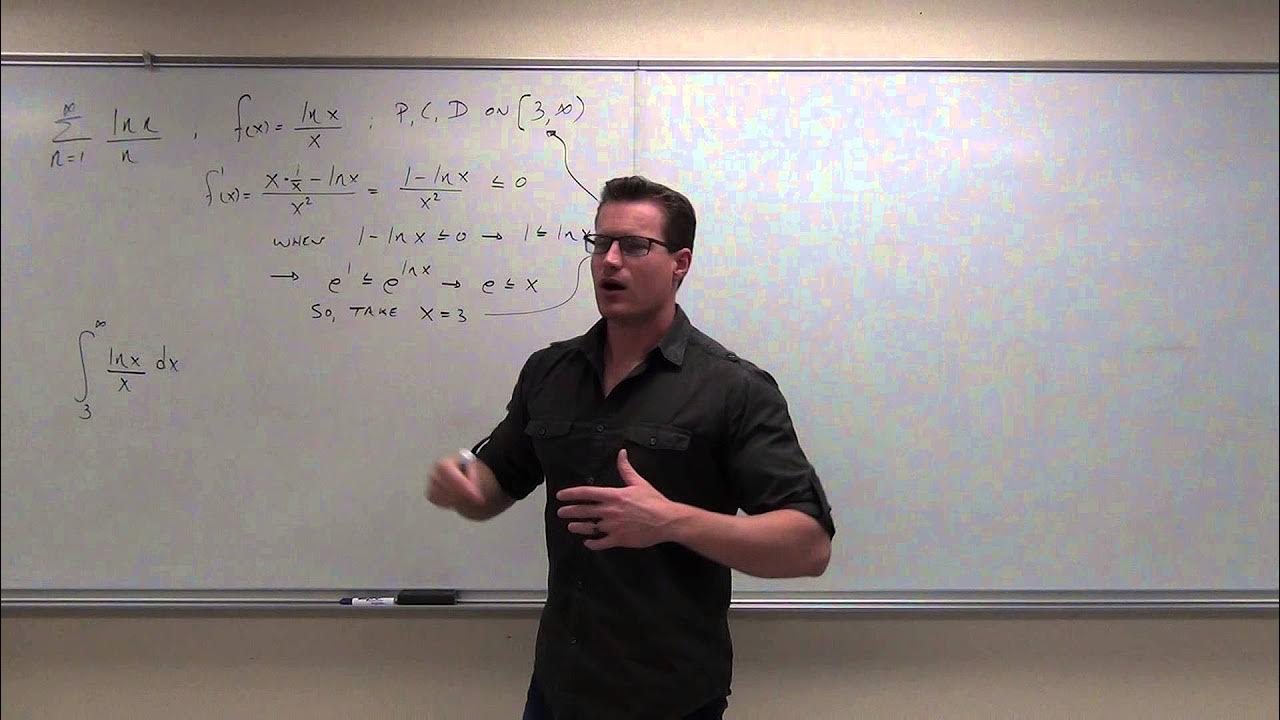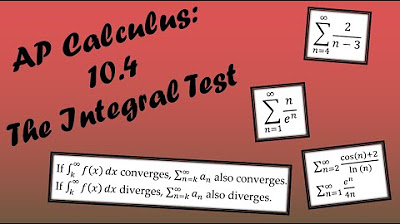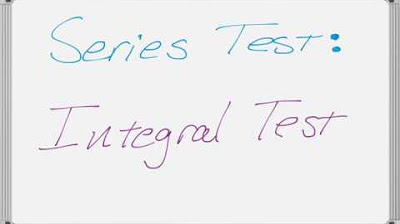Integral Test | MIT 18.01SC Single Variable Calculus, Fall 2010
TLDRThis video script explores the application of the integral test to determine the convergence or divergence of two series involving the natural logarithm function. The presenter guides viewers through the process of using substitution to simplify the integrals and concludes that the first series diverges while the second converges. The importance of checking the conditions for the integral test's applicability is emphasized, ensuring the function is positive and decreasing.
Takeaways
- 📚 The lecture focuses on determining the convergence or divergence of series using various tests, with an emphasis on the integral test.
- 🔍 The integral test is applicable to series that can be compared to an integral of a continuous, positive, and decreasing function.
- 🌟 The first series presented is \( \sum_{n=2}^{\infty} \frac{1}{n \log n} \), and the second is \( \sum_{n=2}^{\infty} \frac{1}{n (\log n)^2} \).
- 🤔 The hint suggests that the integral test might be suitable for these series, given their form and the lack of other applicable tests.
- 📉 The integral test requires checking that the function is decreasing and positive over the interval of interest, which is verified for the given functions.
- 🧩 For the first series, the integral of \( \frac{1}{x \log x} \) from 2 to infinity is calculated using the substitution \( u = \log x \), resulting in a divergent integral.
- 📈 For the second series, the integral of \( \frac{1}{x (\log x)^2} \) is also calculated using the substitution \( u = \log x \), leading to a convergent integral.
- 📝 The convergence of the integral directly implies the convergence of the corresponding series, and vice versa for divergence.
- 📌 The importance of checking the hypotheses of the integral test before applying it is emphasized, ensuring the function is suitable.
- 📚 The lecture provides a practical demonstration of applying the integral test to determine the convergence of series, illustrating both divergent and convergent cases.
- 🔑 The integral test is a powerful tool for analyzing series that are difficult to evaluate directly but have an associated integrable function.
Q & A
What is the main topic discussed in the video script?
-The main topic discussed in the video script is the application of the integral test to determine whether a series converges or diverges.
What are the two series presented in the script for analysis?
-The two series presented are the sum from n=2 to infinity of 1/(n * log(n)) and the sum from n=2 to infinity of 1/(n * (log(n))^2).
What is the integral test mentioned in the script?
-The integral test is a method used to determine the convergence of an infinite series by comparing it to an improper integral. If the integral converges, then so does the series.
Why might the integral test be a suitable choice for the series in the script?
-The integral test is suitable because the given series have integrands that resemble functions for which we have integration techniques, and the series themselves are not easily computable.
What substitution is used to simplify the integral of the first series?
-The substitution used is u = log(x), with du = 1/x dx, to simplify the integral of the first series.
What is the result of the integral test for the first series in the script?
-The result of the integral test for the first series is that the integral diverges, indicating that the series also diverges.
What is the integral associated with the second series in the script?
-The integral associated with the second series is the integral from 2 to infinity of 1/(x * (log(x))^2) dx.
What substitution is used for the integral of the second series?
-The same substitution u = log(x), with du = 1/x dx, is used for the integral of the second series.
What is the result of the integral test for the second series in the script?
-The result of the integral test for the second series is that the integral converges to a finite value, indicating that the series converges as well.
What conditions must be met for the integral test to be valid?
-The integral test is valid if the function used is a decreasing positive function on the interval in question.
How does the script suggest verifying the conditions for the integral test?
-The script suggests checking that the function is positive and either increasing or decreasing over the interval, which is easily verifiable in the given examples.
Outlines
📚 Introduction to Series Convergence and Divergence Tests
This paragraph introduces the topic of determining whether mathematical series converge or diverge, focusing on the integral test. The lecturer presents two new series involving terms with 1/n * log(n) and prompts the audience to consider their convergence. The hint is given that the integral test may be applicable, and the audience is encouraged to pause the video to work on the problem before continuing.
🔍 Applying the Integral Test to Series Analysis
The paragraph delves into the application of the integral test for determining the convergence of series. It suggests looking at the integrands and associated functions to decide on the test's applicability. The lecturer explains that the integral test is chosen due to the lack of other tests and the complexity of the series. The process involves comparing the series to an improper integral and using a substitution method (u = log(x)) to simplify the integral. The first series is shown to diverge, as the integral evaluates to infinity.
📉 Divergence of the First Series and Convergence of the Second
Continuing from the previous paragraph, this section applies the integral test to the second series, using the same substitution method. The integral converges to a finite value, indicating that the series also converges. The lecturer emphasizes the importance of checking the hypotheses of the integral test, ensuring the function is decreasing and positive, before applying the test. The conditions are verified for the given functions, and the conclusion is that the first series diverges while the second converges.
Mindmap
Keywords
💡Recitation
💡Series
💡Convergence
💡Divergence
💡Integral Test
💡Logarithm
💡Substitution
💡Improper Integral
💡Decreasing Function
💡Hypotheses
💡Partial Sums
Highlights
Introduction to the topic of determining whether series converge or diverge using different tests, specifically the integral test.
Presentation of two new series for analysis: 1/(n log n) and 1/(n log^2 n).
Suggestion to pause the video for self-practice before continuing.
Hint given that the integral test might be applicable to the series presented.
Discussion on how to recognize when to use the integral test based on the appearance of the integrands.
Mention of limited tests available for series convergence, making the integral test a likely candidate.
Explanation that the series' convergence is determined by the convergence of the associated improper integral.
Demonstration of the integral test application to the first series, with the integrand 1/(n log n).
Use of substitution method (u = log x) to simplify the integral calculation.
Analysis of the integral's behavior as x approaches infinity to determine convergence.
Conclusion that the first series diverges based on the integral's result.
Application of the integral test to the second series with the integrand 1/(n log^2 n).
Same substitution method applied to the second series for integral simplification.
Integration of 1/u^2 and evaluation of the integral from ln 2 to infinity.
Conclusion that the second series converges based on the finite value of the integral.
Emphasis on checking the hypotheses of the integral test before applying it.
Verification of the function's decreasing positive nature for the integral test's validity.
Final summary of the integral test results for both series, confirming one diverges and one converges.
Transcripts
Browse More Related Video

Calculus 2 Lecture 9.3: Using the Integral Test for Convergence/Divergence of Series, P-Series

AP Calculus BC Lesson 10.4

Calculus Chapter 5 Lecture 51 Convergence Tests 1

Calculus BC – 10.4 Integral Test for Convergence

Worked example: Integral test | Series | AP Calculus BC | Khan Academy

Series Tests - The Integral Test
5.0 / 5 (0 votes)
Thanks for rating: